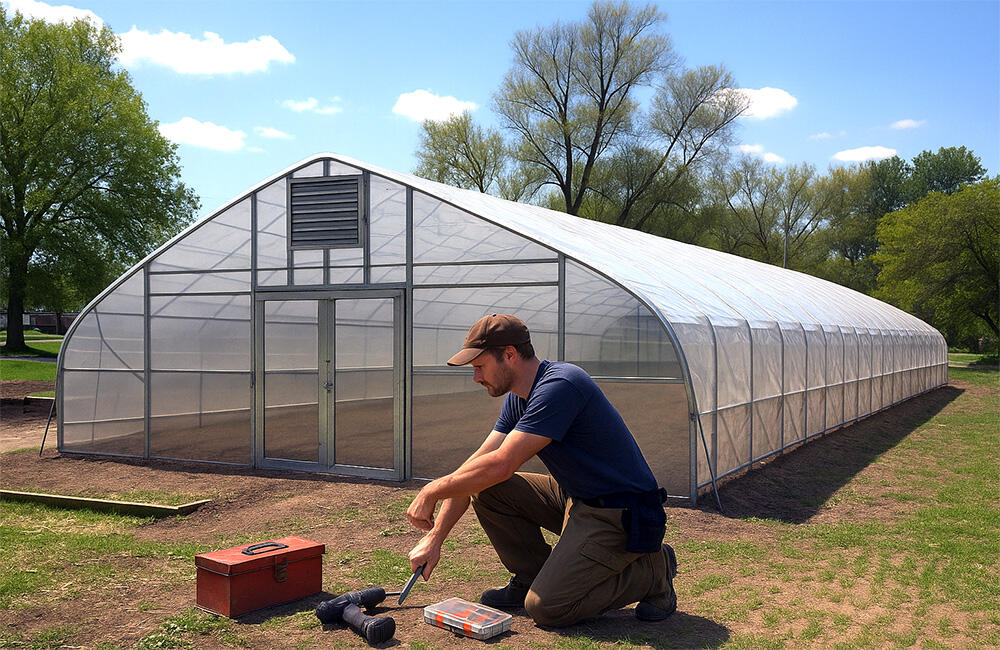Maintaining a greenhouse doesn't have to be a daunting task. Spending a little time on your greenhouse each month is the easiest trick for keeping it strong and letting your plants grow well year after year. By establishing a regular monthly maintenance routine, you not only extend the lifespan of the structure but also create an optimal environment for your crops, ensuring they receive ample light and fresh air. Below, we've compiled a comprehensive list of straightforward tasks that every greenhouse owner should undertake to maximize the return on their initial investment season after season.
Regular Cleaning and Inspection
At the core of effective greenhouse maintenance lies the practice of regular cleaning and inspection. Over time, dust, algae, and bird droppings accumulate on the glass or plastic panels, significantly reducing the amount of sunlight that reaches your plants and disrupting the internal temperature balance. To combat this, set a reminder to wash the panels twice a year, preferably in spring and autumn. Use warm, soapy water and a soft sponge or long-handled brush to gently remove the grime, taking care not to scratch the surface.
While cleaning, it's crucial to conduct a thorough inspection of the greenhouse structure. Look for cracks, loose seals, or signs of rust on the frame. Pay close attention to the joints and connections, as these areas are particularly vulnerable to wear and tear. Make a note of any issues you discover, no matter how minor they may seem. Addressing these small problems promptly can prevent them from escalating into costly repairs down the line and ensure that your plants continue to thrive in a healthy environment.
Climate Control Management
For a greenhouse to be truly productive, maintaining a stable internal climate is essential. Temperature, humidity, and air circulation all play crucial roles in the growth and development of your plants. Invest in an affordable thermostat and hygrometer to monitor these conditions regularly. Aim to keep the temperature within the optimal range for your specific crops, typically between 60°F and 80°F (15°C - 27°C) during the day and slightly cooler at night.
In addition to monitoring the climate, it's important to ensure that your greenhouse's ventilation systems are in good working order. Test the fans, roof vents, and side louvers regularly to make sure they open and close smoothly and are free from dust and debris. During hot summer afternoons, consider using shade cloth to protect tender seedlings from excessive heat and intense sunlight. This simple measure can help prevent wilting and sunburn, allowing your plants to grow strong and healthy.
Pest and Disease Control
Pests and plant diseases can quickly spread through a greenhouse, causing significant damage to your crops if left unchecked. To stay ahead of these threats, make it a habit to walk the rows of your greenhouse every morning and inspect each plant carefully. Look for signs of pest infestation, such as chewed leaves, sticky residue (honeydew), or the presence of insects themselves. Similarly, watch out for symptoms of disease, including discoloration, wilting, or unusual growth patterns.
If you spot any signs of trouble, act promptly. Implement an Integrated Pest Management (IPM) strategy, which may include introducing beneficial insects like ladybugs, using sticky traps to catch flying pests, or applying a mild soap spray to deter insects. Additionally, practice crop rotation each season to prevent the buildup of soil-borne diseases and pests. By diversifying your planting schedule, you can disrupt the life cycles of these unwanted visitors and keep your plants healthy.
Soil and Fertilizer Management
Healthy plants start with healthy soil. Regular soil testing is essential to ensure that your greenhouse soil contains the right balance of nutrients. Test the soil pH and nutrient levels at least twice a year, in spring and fall, and adjust as needed. Most plants prefer a slightly acidic soil with a pH between 6.0 and 7.0. If your soil is too acidic or alkaline, you can add lime or sulfur to adjust the pH.
In addition to testing the soil, it's important to replenish its nutrients regularly. Incorporate fresh compost or worm castings into the soil to improve its structure, drainage, and fertility. These organic amendments also help to increase the soil's water-holding capacity and promote the growth of beneficial soil organisms. You can also add slow-release fertilizers to provide a steady supply of nutrients over time. Be sure to follow the manufacturer's instructions carefully to avoid over-fertilizing, which can damage your plants.
Seasonal Preparations
Each season brings its own unique challenges and opportunities for greenhouse gardening. By taking the time to prepare your greenhouse for the changing weather conditions, you can ensure that your plants continue to thrive throughout the year. In autumn, as the temperatures begin to drop, clean the greenhouse thoroughly, remove any dead plants or debris, and apply a mild disinfectant to the surfaces to prevent the spread of pests and diseases over the winter months.
As spring approaches, it's time to start thinking about getting your greenhouse ready for the growing season. Check the heating system to make sure it's working properly, replace any malfunctioning thermostats, and clean the vents and fans to ensure good air circulation. You may also want to consider adding additional lighting to your greenhouse to provide your plants with the extra light they need during the shorter days of spring.
By following this monthly maintenance checklist, you can keep your greenhouse in top condition, ensuring that your plants receive the care and attention they need to grow strong and healthy. With a little effort and regular maintenance, your greenhouse will become a productive and rewarding part of your gardening experience, providing you with fresh, homegrown produce year after year.
Industry Trends and Innovations
The world of greenhouse gardening is constantly evolving, with new technologies and sustainable practices emerging all the time. More and more growers are turning to smart devices to automate their greenhouse operations. Self-running fans, humidistats, and pocket-size IoT sensors that monitor plant health in real-time are becoming increasingly popular. These innovative gadgets not only reduce labor costs but also minimize the use of chemicals, making greenhouse gardening more environmentally friendly.
At the same time, there is a growing trend towards sustainability in greenhouse design and operation. Many growers are experimenting with plant-friendly plastics, solar-powered equipment, and other low-carbon solutions to reduce their environmental footprint and appeal to eco-conscious consumers. By staying informed about these trends and incorporating new technologies and practices into your greenhouse, you can stay ahead of the competition and ensure the long-term success of your gardening business.


